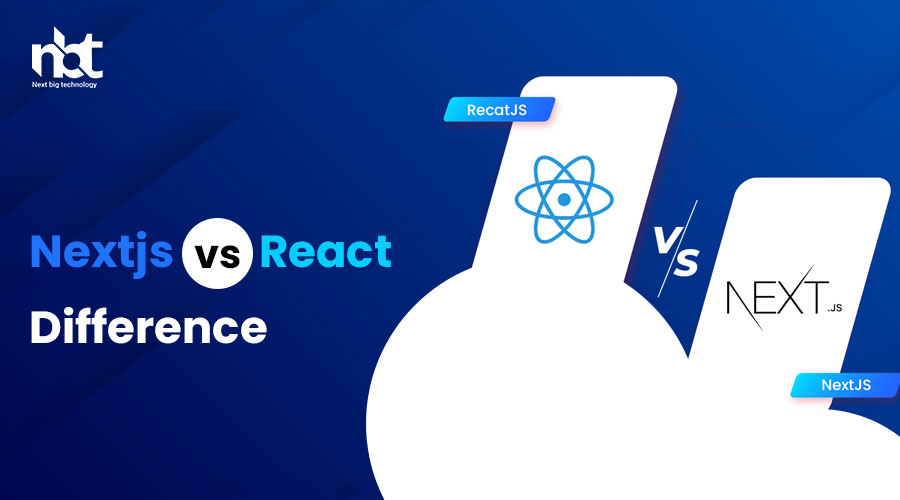Table of Contents
Introduction to Next.js and React
In the vast landscape of web development, staying ahead of the curve is crucial. With the constant evolution of technologies, developers are always on the lookout for tools and frameworks that can streamline their workflow while delivering top-notch performance. In this quest, Next.js and React stand out as formidable allies, offering a potent combination for building modern web applications. Let’s delve into the realm of Next.js and React to unravel their potential and understand why they are gaining traction among developers worldwide.
Understanding React: React has revolutionized the way developers approach building user interfaces (UIs) for web applications. Developed by Facebook, React is an open-source JavaScript library that enables developers to create interactive UI components. Its declarative syntax and component-based architecture provide a structured approach to building UIs, making code modular, reusable, and easier to maintain.
At the heart of React lies the Virtual DOM (Document Object Model), which efficiently updates only the components that have changed, minimizing DOM manipulation and improving performance. This approach, coupled with React’s one-way data binding and state management, empowers developers to create dynamic and responsive UIs with ease.
Introducing Next.js: While React offers a robust foundation for building UI components, Next.js takes web development to the next level by providing a framework for building production-ready React applications. Developed by Vercel, Next.js is an open-source React framework that simplifies the creation of server-rendered (SSR) and statically generated web applications.
One of the key features of Next.js is its support for server-side rendering, which enables faster page loads and improved SEO (Search Engine Optimization) by delivering pre-rendered HTML content to the client. Additionally, Next.js offers built-in routing, code splitting, and automatic server-side rendering, making it ideal for building complex web applications with minimal configuration.
The Power of Integration: When combined, Next.js and React form a powerful duo that empowers developers to build scalable, performant, and SEO-friendly web applications. By leveraging React’s component-based architecture and Next.js’s SSR capabilities, developers can create dynamic web experiences that not only look great but also perform exceptionally well across devices and platforms.
Moreover, the seamless integration between Next.js and React allows developers to leverage the vast ecosystem of React libraries and tools while harnessing the benefits of server-side rendering and static site generation provided by Next.js. This synergy fosters rapid development and enables developers to focus on building features rather than worrying about infrastructure and performance optimization.
Architecture and Purpose
Architecture stands as a testament to human ingenuity and creativity, weaving together artistry, functionality, and purpose into the fabric of our built environment. Beyond the mere arrangement of bricks and mortar, architecture embodies the aspirations, values, and needs of societies throughout history. In this article, we delve into the depths of architecture, unraveling its essence and profound purpose.
Understanding Architecture: Architecture transcends its utilitarian function of providing shelter; it serves as a mirror reflecting the cultural, social, and environmental contexts in which it exists. From the towering skyscrapers of modern cities to the ancient temples of civilizations past, each architectural marvel tells a story of human civilization’s progress, beliefs, and aspirations.
The Essence of Architecture: At its core, architecture is an art form—an expression of human creativity and vision. Architects are the masterminds behind these structures, wielding their imagination and technical prowess to transform abstract concepts into tangible reality. Every line, curve, and material choice is a deliberate decision aimed at evoking emotions, inspiring awe, and fostering connection.
The Purpose of Architecture: While aesthetics play a crucial role, the purpose of architecture extends far beyond beauty alone. It is deeply intertwined with functionality, sustainability, and human well-being. Buildings are designed to accommodate the diverse needs of occupants, whether it’s providing shelter, facilitating commerce, or nurturing social interaction. Moreover, sustainable architecture strives to harmonize with the environment, minimizing its ecological footprint and promoting a healthier planet for future generations.
Architecture and Society: Architecture is inherently social, shaping the way we interact with our surroundings and each other. Iconic landmarks become symbols of identity and pride for communities, fostering a sense of belonging and unity. Furthermore, architecture has the power to address societal challenges, such as urbanization, inequality, and climate change. Thoughtfully designed spaces can enhance livability, promote inclusivity, and catalyze positive change on a societal scale.
Server-Side Rendering (SSR) Capabilities
In the dynamic landscape of web development, Server-Side Rendering (SSR) stands as a pivotal technique revolutionizing the way web pages are delivered to users. In this comprehensive guide, we delve into the depths of SSR capabilities, unraveling its significance and benefits in the modern web development sphere.
Understanding Server-Side Rendering (SSR): Server-Side Rendering (SSR) is a technique where a web server generates HTML pages with content that is dynamically injected before sending them to the client. Unlike Client-Side Rendering (CSR), where the rendering process occurs on the user’s browser, SSR performs rendering on the server before serving the page to the client’s browser.
Unparalleled Performance: One of the most prominent advantages of SSR is its ability to enhance performance and user experience. By pre-rendering HTML on the server, SSR reduces the time it takes for a webpage to load, resulting in faster initial page rendering. This leads to lower bounce rates, improved SEO rankings, and ultimately, happier users.
SEO Friendliness: In the realm of search engine optimization (SEO), SSR shines brightly. Search engine crawlers can easily index pre-rendered HTML content, ensuring better visibility and ranking for SSR-powered websites. By delivering fully rendered pages to search engines, SSR empowers websites to climb the search result rankings, driving organic traffic and boosting online presence.
Enhanced Accessibility and UX: SSR plays a crucial role in enhancing accessibility and user experience (UX) across various devices and network conditions. By delivering pre-rendered HTML content, SSR ensures that users receive a consistent and optimized experience, regardless of their device or network speed. This results in reduced loading times and smoother interactions, fostering positive user engagement and satisfaction.
Seamless Content Updates: With SSR, content updates become seamless and effortless. Since the rendering process occurs on the server, updates to content can be reflected instantly across all users’ browsers, eliminating the need for manual cache purging or client-side re-rendering. This agility in content updates ensures that users always have access to the latest information, keeping websites relevant and dynamic.
Client-Side Rendering (CSR) Performance
In the realm of web development, Client-Side Rendering (CSR) has emerged as a popular approach for building dynamic and interactive web applications. Unlike Server-Side Rendering (SSR), where the server generates the complete HTML markup for each request, CSR shifts the rendering process to the client’s browser, allowing for faster initial page loads and smoother user interactions. However, while CSR offers numerous advantages, optimizing its performance remains a critical concern for developers aiming to deliver exceptional user experiences.
Understanding Client-Side Rendering (CSR)
Client-Side Rendering involves the generation of HTML, CSS, and JavaScript on the client side, typically through frameworks like React, Angular, or Vue.js. When a user visits a CSR-based web application, the browser downloads the minimal HTML content and then executes JavaScript to render the complete UI dynamically. This approach enhances interactivity and enables seamless updates without full-page reloads.
Performance Challenges
Despite its benefits, CSR introduces several performance challenges that developers must address:
- Initial Load Time: Since the browser needs to download JavaScript bundles and execute them before rendering, the initial load time can be longer compared to SSR or traditional server-rendered web applications.
- Search Engine Optimization (SEO): Search engine crawlers may struggle to index content rendered dynamically via JavaScript, potentially impacting the discoverability of CSR-based websites.
- Time to Interactivity (TTI): Excessive JavaScript execution can delay the time until users can interact with the page, leading to poor perceived performance.
Strategies for Enhancing CSR Performance:
To overcome these challenges and ensure optimal CSR performance, developers can implement the following strategies:
- Code Splitting: Divide the JavaScript code into smaller, manageable chunks and load them asynchronously based on user interactions or page routes. This reduces the initial load time by fetching only the essential code required for rendering the current view.
- Server-Side Rendering for Critical Content: While the main content can be rendered on the client side, consider rendering critical content, such as metadata or static portions of the page, on the server. This improves SEO and provides a faster initial render for users.
- Lazy Loading and Dynamic Imports: Utilize lazy loading techniques to defer the loading of non-essential resources, such as images or secondary components, until they are needed. Dynamic imports allow for on-demand loading of JavaScript modules, further reducing the initial payload size.
- Optimized Bundle Size: Minimize the size of JavaScript bundles by eliminating unnecessary dependencies, using tree shaking, and leveraging tools like Webpack to optimize code for production. Smaller bundle sizes lead to faster downloads and execution times.
- Prefetching and Caching: Anticipate user interactions and prefetch resources, such as data or code, in advance to reduce latency. Additionally, implement caching mechanisms, both on the client and server side, to store frequently accessed data and avoid redundant requests.
- Progressive Enhancement: Design applications with progressive enhancement in mind, ensuring that core functionality is accessible even in environments with limited JavaScript support or slower network connections. This approach improves accessibility and resilience while maintaining a rich user experience.
API Handling and Integration
In the rapidly evolving landscape of technology, Application Programming Interfaces (APIs) have become the cornerstone of modern software development. APIs enable different software systems to communicate and share data seamlessly, unlocking a world of possibilities for developers to create powerful applications. From social media platforms to e-commerce websites and beyond, APIs are ubiquitous, facilitating the exchange of information and functionality across diverse platforms.
Understanding API Handling
API handling refers to the process of interacting with APIs to send requests, receive responses, and integrate their functionality into your applications. Whether you’re retrieving data, performing actions, or accessing services, effective API handling is essential for building robust and efficient software solutions.
Key Components of API Handling:
- Authentication and Authorization: Before accessing an API, authentication and authorization mechanisms must be implemented to ensure secure communication between the client and the server. This often involves obtaining API keys, tokens, or using OAuth protocols to authenticate users and control access to resources.
- Request Formation: Crafting well-formed requests is crucial for communicating effectively with an API. This includes specifying the HTTP method (GET, POST, PUT, DELETE), providing necessary parameters or payloads, and handling headers such as Content-Type and Accept to ensure compatibility with the API endpoint.
- Error Handling: APIs can encounter errors for various reasons, such as invalid input, server issues, or rate limiting. Proper error handling mechanisms should be implemented to gracefully handle these scenarios, providing meaningful feedback to users and ensuring the stability of your application.
Integrating APIs into Your Application
Integrating APIs into your application opens up a world of possibilities, allowing you to leverage external services and functionalities to enhance your software. Whether you’re integrating payment gateways, social media sharing, mapping services, or any other API, following best practices is essential for seamless integration.
Best Practices for API Integration:
- Read the Documentation: Familiarize yourself with the API documentation provided by the service provider. Understanding the endpoints, parameters, authentication methods, and response formats is crucial for successful integration.
- Use SDKs or Libraries: Many APIs offer Software Development Kits (SDKs) or libraries in various programming languages, simplifying the integration process by providing pre-built functions and handling low-level details.
- Implement Caching: To improve performance and reduce unnecessary API calls, consider implementing caching mechanisms to store frequently accessed data locally. This can help minimize latency and improve the overall responsiveness of your application.
- Monitor and Analyze Usage: Keep track of API usage metrics such as request rates, response times, and error rates to identify potential bottlenecks or issues. Monitoring usage patterns can also help optimize resource allocation and anticipate scaling requirements.
State Management Options
In the dynamic world of web development, efficient state management is crucial for building robust and responsive applications. State management refers to the management of data within an application, encompassing everything from user input and UI state to server responses and cached data. With various options available, developers must choose the most suitable state management solution based on the specific requirements of their project. Let’s delve into some popular state management options and explore their strengths and use cases.
1. Local Component State: Local component state, inherent to frameworks like React, allows developers to manage state within individual components. It’s ideal for managing UI-specific data such as form inputs, toggles, and modal visibility. While simple to implement and understand, it can become cumbersome for large-scale applications with complex state interactions.
2. Context API (React): The Context API in React provides a way to share state across multiple components without having to pass props manually at every level. It’s suitable for prop drilling scenarios where multiple components need access to the same data. However, it may lead to performance issues when used excessively due to frequent re-renders.
3. Redux: Redux is a predictable state container for JavaScript apps, commonly used with React but also compatible with other frameworks. It centralizes application state in a single store, making it easy to manage and debug. Redux’s strict unidirectional data flow simplifies state tracking and enables powerful debugging tools like time-travel debugging. However, its boilerplate code and steep learning curve can be daunting for beginners and may not be necessary for smaller applications.
4. MobX: MobX is a simple and scalable state management library that focuses on making state management simple and intuitive. It utilizes observable data structures to automatically track and update state changes, reducing the need for manual management. MobX’s minimalistic approach and ease of use make it an attractive choice for rapidly developing applications. However, its reliance on implicit reactivity can lead to unexpected behavior if not carefully managed.
5. Context API + useReducer (React): Combining the Context API with the useReducer hook in React offers a middle ground between local component state and Redux. It allows for centralized state management with predictable state transitions and enables fine-grained control over state updates. This approach is suitable for medium-sized applications where the complexity of Redux isn’t justified but the simplicity of local component state falls short.
6. GraphQL with Apollo Client: For applications with complex data fetching requirements, GraphQL combined with Apollo Client provides a powerful solution for managing client-side state. Apollo Client integrates seamlessly with GraphQL APIs and offers features like caching, optimistic UI updates, and local state management. It’s particularly beneficial for applications with real-time data needs, such as chat apps or live dashboards.
Code Splitting and Bundling
In the dynamic realm of web development, where user experience reigns supreme, optimizing website performance is non-negotiable. Among the arsenal of techniques available, code splitting and bundling emerge as indispensable strategies to enhance efficiency and speed. This article delves into the intricacies of code splitting and bundling, elucidating their significance and providing actionable insights for implementation.
Understanding Code Splitting
Code splitting is a technique used to improve website performance by breaking down large bundles of JavaScript code into smaller, more manageable chunks. Traditionally, web applications load all JavaScript code upfront, leading to longer initial load times and decreased user experience, especially on slower networks or devices. Code splitting mitigates this issue by dividing the codebase into smaller modules that are loaded on-demand, reducing the initial payload and improving performance.
Benefits of Code Splitting:
- Faster Initial Load Times: By loading only the essential code required for the initial page render, code splitting significantly reduces the time it takes for a website to become interactive. Users experience quicker load times, enhancing overall satisfaction.
- Improved Performance: Smaller bundles lead to faster parsing and execution of JavaScript, resulting in smoother user interactions and reduced latency. This is particularly advantageous for complex web applications with extensive JavaScript functionality.
- Optimized Caching: Code splitting enables more efficient caching mechanisms since each module can be cached independently. Subsequent visits to the website benefit from cached modules, further enhancing performance and reducing server load.
Implementing Code Splitting:
- Webpack Dynamic Imports: Modern bundlers like Webpack support dynamic imports, allowing developers to split their code into separate bundles that are loaded asynchronously. This can be achieved using syntax like
import()to specify which modules should be loaded on-demand. - Route-based Splitting: For single-page applications (SPAs), code splitting can be implemented based on application routes. Each route can have its own bundle, ensuring that only the necessary code is loaded when navigating between pages.
- Component-based Splitting: In component-based frameworks like React or Vue.js, code splitting can be applied at the component level. Lazy loading components ensure that only the components needed for the current view are loaded, improving performance and reducing unnecessary overhead.
Understanding Bundling
While code splitting focuses on breaking down code into smaller modules, bundling consolidates these modules into larger bundles for deployment. Bundling is a crucial step in the web development workflow, as it reduces the number of HTTP requests required to load a webpage and facilitates efficient resource delivery.
Benefits of Bundling:
- Reduced Network Overhead: Bundling allows multiple files to be combined into a single bundle, reducing the number of HTTP requests required to fetch resources. This minimizes network overhead and accelerates page load times, particularly on bandwidth-constrained networks.
- Optimized Compression: Bundling enables better compression techniques to be applied to the entire codebase, resulting in smaller file sizes and faster downloads. Gzip or Brotli compression can be more effectively utilized on bundled files, further enhancing performance.
- Simplified Deployment: Bundling simplifies the deployment process by consolidating all necessary files into a single package. This streamlines version control, deployment automation, and maintenance, leading to a more efficient development workflow.
Implementing Bundling:
- Webpack: Webpack is a popular bundling tool in the JavaScript ecosystem, offering robust capabilities for bundling JavaScript, CSS, and other assets. Its configuration-based approach allows developers to customize the bundling process according to project requirements.
- Parcel: Parcel is another bundler gaining traction for its simplicity and zero-config setup. It automatically analyzes project dependencies and generates optimized bundles without the need for manual configuration, making it ideal for quick prototyping and small to medium-sized projects.
- Rollup: Rollup is a JavaScript module bundler focused on producing smaller, faster, and more efficient bundles. It excels at tree-shaking, a technique for eliminating unused code, resulting in leaner bundles and improved performance.
Scalability and Maintainability
In the ever-evolving landscape of modern business, two key factors play a pivotal role in determining long-term success: scalability and maintainability. As enterprises strive to adapt to dynamic market demands and technological advancements, ensuring that systems and processes can both scale efficiently and be maintained effectively is essential. Let’s delve into what scalability and maintainability entail and how businesses can optimize these aspects to stay competitive in today’s fast-paced world.
Understanding Scalability
Scalability refers to the ability of a system, process, or organization to handle growing amounts of work, transactions, or users without compromising performance or functionality. In simpler terms, it’s about being able to expand operations seamlessly as demand increases. Whether it’s accommodating a surge in website traffic, processing a higher volume of sales orders, or supporting a growing user base, scalability is crucial for sustainable growth.
Key Considerations for Achieving Scalability:
- Flexible Infrastructure: Invest in infrastructure that can adapt to changing needs without requiring a complete overhaul. Cloud computing services offer scalable solutions, allowing businesses to adjust resources on-demand based on traffic spikes or seasonal variations.
- Modular Design: Adopt a modular approach to system architecture and software development. Breaking down complex systems into smaller, independent components enables easier scalability by allowing for incremental upgrades and additions as requirements evolve.
- Horizontal Scaling: Implement strategies for horizontal scaling, where additional resources such as servers or instances are added to distribute the workload. Load balancers can evenly distribute incoming traffic across multiple servers, preventing any single point of failure.
- Performance Monitoring: Continuously monitor system performance and identify potential bottlenecks or resource constraints. Proactive monitoring allows for timely adjustments and optimizations to maintain optimal scalability.
The Importance of Maintainability
Maintainability refers to the ease with which a system or process can be modified, updated, or repaired over time. It encompasses factors such as code readability, documentation, and adherence to best practices. A maintainable system not only reduces the cost and effort required for ongoing maintenance but also facilitates innovation and agility by enabling swift changes in response to evolving business needs.
Strategies for Enhancing Maintainability:
- Clean Code Practices: Emphasize clean coding practices such as modularization, meaningful variable names, and consistent formatting. Well-structured code is easier to understand, debug, and modify, reducing the risk of introducing errors during maintenance.
- Comprehensive Documentation: Documenting code, configurations, and system architectures is crucial for facilitating knowledge transfer and troubleshooting. Maintain up-to-date documentation that provides insights into system design, dependencies, and operational procedures.
- Version Control: Utilize version control systems like Git to track changes to codebases and collaborate effectively among development teams. Version control ensures transparency, accountability, and the ability to revert to previous states if needed.
- Automated Testing: Implement automated testing frameworks to validate code changes and prevent regressions. Unit tests, integration tests, and continuous integration pipelines help maintain code quality and stability throughout the development lifecycle.
Finding the Balance
Achieving optimal scalability and maintainability requires striking a delicate balance between accommodating growth and preserving stability. While scalability focuses on accommodating increasing demands, maintainability ensures that systems remain robust and adaptable in the face of change. By prioritizing both aspects and implementing best practices, businesses can build resilient infrastructures capable of thriving in today’s dynamic business environment.
Learning Curve and Documentation
In the pursuit of mastering any skill or field of knowledge, one encounters what is commonly known as the learning curve. This curve represents the journey from initial unfamiliarity to proficiency, and finally, mastery. While this process can be both exciting and challenging, one factor that significantly influences the trajectory of this curve is documentation.
Documentation plays a pivotal role in facilitating learning and skill acquisition. Whether it’s in the realms of academia, professional development, or personal interests, having comprehensive documentation can greatly expedite the learning process. Here’s why documentation is indispensable in navigating the learning curve:
- Clarity and Structure: Documentation provides a structured pathway for learners to follow. It outlines the foundational concepts, key principles, and sequential steps necessary for skill acquisition. By offering clarity and structure, documentation helps learners understand where they stand in their journey and what steps they need to take next.
- Reference Material: In the vast sea of information available today, documentation serves as a reliable reference material. Learners can refer back to documented resources whenever they encounter challenges or need to reinforce their understanding of a particular concept. This quick access to information accelerates the learning process and mitigates the risk of getting lost in a maze of information overload.
- Knowledge Retention: The act of documenting what one learns enhances knowledge retention. When learners actively engage with the material by summarizing, organizing, and articulating it in their own words, they reinforce their understanding and commit the information to memory more effectively. This process transforms passive consumption into active learning, thereby maximizing the retention of knowledge and skills.
- Facilitating Collaboration: Documentation fosters collaboration among learners by providing a shared platform for exchanging ideas, insights, and best practices. Collaborative documentation allows learners to benefit from collective wisdom, diverse perspectives, and peer feedback. Through collaborative efforts, learners can collectively overcome challenges, explore new avenues, and accelerate their progress along the learning curve.
- Continuous Improvement: Documenting one’s learning journey enables continuous improvement and refinement of skills. By periodically revisiting and updating documentation, learners can track their progress, identify areas for improvement, and set new goals. This reflective practice fosters a growth mindset, where setbacks are viewed as opportunities for learning and improvement, rather than obstacles to success.
- Knowledge Transfer: Documentation ensures the preservation and transfer of knowledge across time and space. It allows individuals to share their expertise, insights, and experiences with others, thereby enriching the collective knowledge pool. Through documentation, learners can benefit from the wisdom of those who have traversed similar learning curves, avoiding common pitfalls and accelerating their own progress.
Top Nextjs And React Development Companies
In today’s tech-savvy world, the demand for Next.js and React development expertise is skyrocketing as businesses strive to deliver seamless, interactive, and dynamic web applications. With these cutting-edge technologies, companies can create lightning-fast and highly responsive web experiences, captivating users and driving business growth. However, finding the right development partner to bring your vision to life can be a daunting task amidst the sea of options available in the market.
Fear not, as we’ve curated a list of the top Next.js and React development companies that stand out for their exceptional skills, innovative approaches, and proven track records in delivering outstanding solutions. Whether you’re a startup looking to build your MVP or an enterprise aiming to revamp your digital presence, these companies are poised to exceed your expectations.
-
-
Next Big Technology:

Focus Area
- Mobile App Development
- App Designing (UI/UX)
- Software Development
- Web Development
- AR & VR Development
- Big Data & BI
- Cloud Computing Services
- DevOps
- E-commerce Development
Industries Focus
- Art, Entertainment & Music
- Business Services
- Consumer Products
- Designing
- Education
- Financial & Payments
- Gaming
- Government
- Healthcare & Medical
- Hospitality
- Information Technology
- Legal & Compliance
- Manufacturing
- Media
-
- Binary Minds: Binary Minds is synonymous with excellence in Next.js and React development, renowned for its collaborative approach and commitment to client satisfaction. Armed with a deep understanding of user experience design and technical expertise, their talented professionals breathe life into projects of all sizes, transforming ideas into captivating digital experiences. Whether it’s building scalable web applications or crafting intuitive interfaces, Binary Minds delivers solutions that resonate with users and drive business success.
- CodeCrafters Inc.: As pioneers in Next.js and React development, CodeCrafters Inc. combines technical prowess with a passion for innovation to deliver cutting-edge solutions that push the boundaries of possibility. Their multidisciplinary team thrives on tackling complex challenges and turning them into opportunities for growth. With a client-centric approach and a focus on continuous improvement, CodeCrafters Inc. empowers businesses to stay ahead of the curve in today’s rapidly evolving digital landscape.
- PixelPioneers: PixelPioneers stands out as a beacon of creativity and excellence in Next.js and React development, renowned for its ability to transform ideas into visually stunning and functionally robust web applications. With a meticulous attention to detail and a flair for innovation, their team crafts solutions that not only meet but exceed clients’ expectations. Whether it’s building immersive user interfaces or optimizing performance for maximum impact, PixelPioneers delivers results that leave a lasting impression.
- TechTorch Solutions: TechTorch Solutions emerges as a trusted partner for Next.js and React development, distinguished by its unwavering commitment to quality, transparency, and integrity. With a focus on collaboration and communication, their dedicated team works closely with clients to understand their needs and objectives, delivering solutions that align perfectly with their business goals. From inception to deployment and beyond, TechTorch Solutions ensures a smooth and successful development journey, driving tangible results and fostering long-term partnerships.
FAQs On Nextjs And React Development
In the ever-evolving landscape of web development, React and Next.js have emerged as powerful tools that streamline the process of building interactive and dynamic web applications. However, navigating through the intricacies of these frameworks can sometimes raise questions. Here, we address some frequently asked questions (FAQs) about Next.js and React development to provide clarity and guidance.
What is Next.js, and how does it relate to React? Next.js is a framework built on top of React, offering additional features and functionalities to enhance the development experience. It provides server-side rendering, automatic code splitting, and simpler configuration, making it an ideal choice for building production-ready React applications. Essentially, Next.js simplifies React development by handling routing, server-side rendering, and other aspects, allowing developers to focus more on building the application logic.
Why should I choose Next.js over traditional React? While React is a powerful library for building user interfaces, Next.js extends its capabilities by adding features like server-side rendering, static site generation, and automatic code splitting out of the box. These features improve performance, SEO, and user experience, especially for larger applications or websites with dynamic content. Moreover, Next.js simplifies the setup process and provides a more structured approach to building React applications, thereby boosting developer productivity.
Is Next.js suitable for SEO optimization? Yes, one of the significant advantages of Next.js is its built-in support for server-side rendering (SSR) and static site generation (SSG), which greatly enhances SEO performance. SSR ensures that search engine crawlers receive fully-rendered HTML content, making it easier for them to index and rank pages. Additionally, Next.js optimizes client-side navigation, reducing the time-to-first-byte (TTFB) and improving overall page load speed, both of which are crucial factors for SEO.
Can I deploy Next.js applications on different hosting platforms? Absolutely! Next.js applications can be deployed on various hosting platforms, including popular choices like Vercel, Netlify, and Heroku, among others. These platforms offer seamless integration with Next.js projects, providing features like automatic deployments, built-in CI/CD pipelines, and scalability options. Whether you prefer a fully-managed platform or self-hosting, Next.js offers flexibility in deployment, ensuring smooth deployment experiences regardless of your hosting choice.
How does Next.js handle data fetching? Next.js provides multiple methods for data fetching, including static generation (getStaticProps), server-side rendering (getServerSideProps), and client-side rendering (useEffect with fetch). The choice of method depends on various factors such as the data source, frequency of updates, and performance requirements. For static data that doesn’t change frequently, static generation is recommended, whereas for dynamic data or personalized content, server-side rendering or client-side fetching may be more appropriate.
Can I use Next.js with other libraries and frameworks? Yes, Next.js is highly compatible with other libraries and frameworks commonly used in the React ecosystem. You can easily integrate Next.js with state management libraries like Redux or MobX, styling solutions like Styled Components or Tailwind CSS, and testing frameworks like Jest or React Testing Library. Moreover, Next.js allows you to extend its functionality through custom server APIs, middleware, and plugins, offering endless possibilities for integration with third-party tools and services.
Thanks for reading our post “Nextjs vs. React Difference”. Please connect with us to learn more about Best Nextjs or React.






















